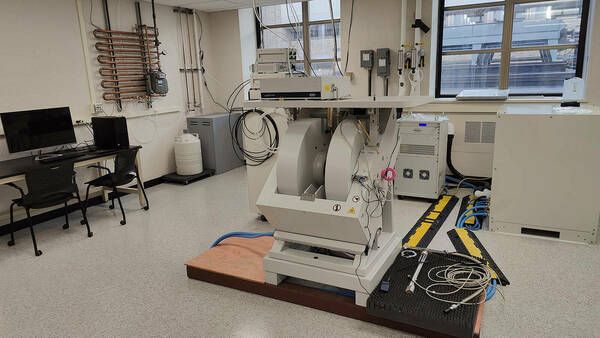Bruker Elexsys II X-band Electron Spin Resonance (ESR/EPR) Spectrometer

Applications
When the molecules of a solid exhibit paramagnetism as a result of unpaired electron spins, transitions can be induced between spin states by applying a magnetic field and then supplying electromagnetic energy, usually in the microwave range of frequencies. The resulting absorption spectra are described as electron spin resonance (ESR) or electron paramagnetic resonance (EPR). Electron spin resonance has been used as an investigative tool for the study of radicals formed in solid materials, since the radicals typically produce an unpaired spin on the molecule from which an electron is removed. Particularly fruitful has been the study of the ESR spectra of radicals produced as radiation damage from ionizing radiation. Study of the radicals produced by such radiation gives information about the locations and mechanisms of radiation damage. Furthermore, ESR is a powerful tool to study conducting electrons, as well as localized spin centers. It can thus yield direct information regarding the nature of the spin species. The main detectable quantities are χ0 (static spin susceptibility), g (electron g-factor), T1/T2 relaxation times.
Location
220 Nieuwland Science Hall - Complex Quantum Matter Laboratory
Contact person: Bence G Markus
Capabilities
Properties:
- Temperature range: 3.8 - 1200 K
- Magnetic field: 0 - 14500 G
Available options:
- SuperX CW microwave bridge (9.2 - 9.9 GHz; 200 nW - 200 mW power)
- Oxford E900 He flow cryostat (3.8 - 275 K)
- Bruker LN2 flow cryostat + N2 booster (105 - 400 K)
- Light-induced ESR studies with variable laser excitations
Resonators:
learn more about the resonators
- ER4122SHQE Universal resonator (compatible with both cryostats)
- ER4102ST Rectangular resonator + cooling sideplates
- ER4123D Dielectric resonator
- ER4114HT High Temperature resonator (300 - 1200 K)
Related work
-
A. Bojtor, S. Kollarics, B. G. Márkus, A. Sienkiewicz, M. Kollár, L. Forró, F. Simon: Ultralong Charge Carrier Recombination Time in Methylammonium Lead Halide Perovskites, ACS Photonics 9, 3341-3350 (2022)
-
S. Kollarics, F. Simon, A. Bojtor, K. Koltai, G. Klujber, M. Szieberth, B. G. Márkus, D. Beke, K. Kamarás, A. Gali, D. Amirari, R. Berry, S. Boucher, D. Gavryushkin, G. Jeschke, J. P. Cleveland, S. Takahashi, P. Szirmai, L. Forró, E. Emmanouilidou, R. Singh, K. Holczer: Ultrahigh nitrogen-vacancy center concentration in diamond, Carbon 188, 393-400 (2022)